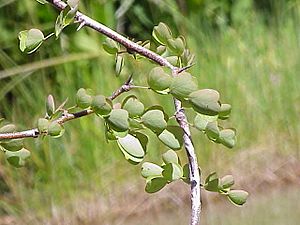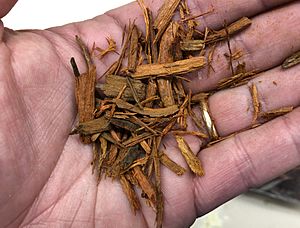Blackwood facts for kids
Quick facts for kids Blackwood |
|
|---|---|
 |
|
| Conservation status | |
| Scientific classification | |
| Genus: |
Haematoxylum
|
| Species: |
campechianum
|
| Synonyms | |
|
|
Logwood, also known as Haematoxylum campechianum, is a special flowering tree. It belongs to the legume family, called Fabaceae. This tree originally comes from southern Mexico. People there call it Árbol de campeche.
Over time, logwood was also brought to the Caribbean, northern Central America, and other parts of the world. From the 1600s to the 1800s, this tree was very important for money. People would cut down the trees and send the wood to Europe. There, it was used to dye fabrics. The country of Belize today grew from these early logging camps. These camps were set up by the English in the 1600s and 1700s. The scientific name for the tree, Haematoxylum, means "bloodwood." This comes from the Greek words haima (blood) and xylon (wood).
What is Logwood Used For?
Logwood, or Haematoxylum campechianum, has been used for a very long time. It was a natural source of dye. Even today, the woodchips from this tree are important. They are used to make haematoxylin. This substance helps scientists in histology to stain tiny parts of cells and tissues. This helps them see things better under a microscope.
The bark and leaves of the logwood tree are also used. They have been part of different traditional medicines. In the past, logwood was a very useful dye. It was widely used to color textiles, like clothes, and also for paper.
The liquid taken from logwood was once used as a pH indicator. This means it could show if something was an acid or a base. When it was neutral, it looked brownish. If it touched something acidic, it turned yellow-reddish. If it touched something alkaline (a base), it turned purple. For example, if you put a drop of logwood extract near ammonia vapor, the extract would turn purple.

Logwood and Pirates: A Surprising Connection
Logwood played a big part in the lives of buccaneers in the 1600s. It was also important during the Golden Age of Piracy in the early 1700s. Spain claimed all of Central and South America as its own land. But English, Dutch, and French sailors knew how valuable logwood was. They set up camps to cut down these trees. Then, they would send the wood back to Europe.
Spain would sometimes send ships called privateers to catch these logwood cutters. For example, Juan Corso did this in 1680. Sometimes, this was in return for buccaneers attacking Spanish cities. When logwood cutters lost their jobs because of these attacks, many joined pirate crews. They would then raid the Spanish in return. Edmund Cooke joined pirates after Spain took two of his logwood ships.
In 1715, Spanish forces forced many logwood cutters out of their camps. These cutters then went to Nassau. This made the number of pirates there even bigger. By the mid-1720s, logwood cutters themselves became targets for pirates. Pirates like Francis Spriggs, Edward Low, and George Lowther attacked them. Famous pirate captains like Samuel Bellamy and Blackbeard even turned captured logwood-hauling sloops into their own pirate ships!
Cutting logwood was a good way to make money. It was a smaller business, but it was important for many former sailors and pirates.
Gallery
See also
 In Spanish: Haematoxylum campechianum para niños
In Spanish: Haematoxylum campechianum para niños




